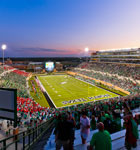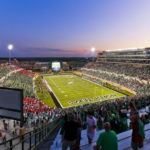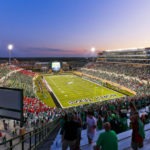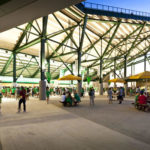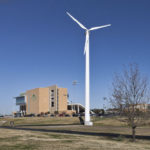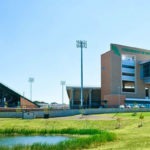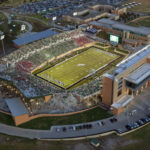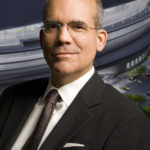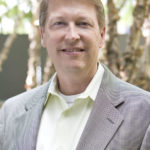
Bryan Trubey served as HKS's design principal for the Apogee Stadium project.
It may no longer be called “Mean Green Stadium,” but the University of North Texas’s Apogee Stadium retains the distinguished honor of being the only LEED Platinum structure of its kind in the country. Behind the project is Dallas-based HKS, a top-five international firm dedicated solely to architectural design and a company that has a history of designing stadiums of all types. Bryan Trubey, design principal for Apogee Stadium, has masterminded facilities the world over; his CV includes the Dallas Cowboys Stadium, the Liverpool FC Stadium, and venues for the 2014 FIFA World Cup in Brazil. Working with him on the Apogee project was HKS chief sustainability officer Kirk Teske and sustainability director Chris Mundell.
“We differentiate our firm by focusing on the long-term sustainability of the structure,” Trubey says. “Can that building remain sustainable from a revenue and experience standpoint over a period of 30, 40, 50 years? That’s where we spend our time—looking at future use scenarios for properties, and from a sustainability standpoint, it’s a much more holistic view.”
This sensibility was a perfect match for HKS’s environmentally conscious client, the University of North Texas (UNT), which is working toward a climate action plan with a carbon-neutrality goal by 2040. “A primary driver for this design was to meet their environmental and climate action plan goals,” Teske says of the university. “While they had completed LEED certification on some of their prior facilities, this was their first Platinum-level project.”

The way to LEED Platinum is paved with permeable pavers. This highly durable, green choice for the Apogee parking lot significantly reduces storm-water runoff.

The wind turbines at UNT’s Apogee Stadium were installed by Cascade Renewable Energy. The turnkey clean-energy systems helped HKS and the entire project team achieve a true industry first: the first LEED Platinum-certified stadium in the country.

Built on a restored park, Apogee Stadium rests lightly on its site while taking advantage of existing retention ponds.
Perhaps the most visible green element at Apogee Stadium is its three Northern Power 100 wind turbines, installed by Cascade Renewable Energy. This particular model was chosen for its durability, low maintenance—it’s designed for power production in the Arctic—and for the fact that it’s domestically manufactured (American Recovery and Reinvestment Act funding stipulates a domestic product). “They’re prominent,” Mundell says of the turbines, “but they’re also the right scale for the location and work well with low to medium wind speed—perfect for the site.”
Though there’s no hiding wind turbines, part of the architects’ strategy was to minimize disruption to the site and any existing trees. To this end, the stadium was built into the slope of the site, minimizing the amount of excavation required. The site was previously a golf course but master-planned to be restored as a park. This provided HKS with storm-water-retention ponds (100 percent of storm water is managed on site), and after landscaping the site with native vegetation, the new design costs UNT less to maintain than the previous setup.
“The unique thing about stadia is that they don’t operate all the time,” Teske says, “so it’s more difficult to justify high-performance equipment, especially as you’re not using that equipment between events.” UNT, however, opted for the more efficient option of a central chilled water system (choosing the Smardt Model WA-240 chillers for the system), as opposed to rooftop units.
UNT didn’t stop with water; it installed a full enthalpy recovery wheel on the exhaust and return air streams, with 100-percent outside air economizers by Trane to cool the suites and club spaces (the air handling unit is the TSCX008 and the remote terminal unit is the CS1A030 and CSIA080). Smith Seckman Reid served as the mechanical engineer for the Apogee project, and project manager David Ballard says, “These Trane units were selected because of their ability to deliver high-performance, two-inch double-wall, foam-injected construction, which have ultra-low leakage rates and provide a true thermal break to prevent heat loss through the casing. In addition, each unit is provided with multiple variable-speed direct-drive plenum fans with premium efficiency motors to exactly match building load and minimize fan energy use.”
“The payback is longer but still within a 20-year period,” Teske adds. “A lot of our clients will make decisions on a ten-year-or-less time frame. UNT took the longer view to shape some of their decisions.” Fortunately, the project itself didn’t take a proportionate time to complete, starting in February 2002 and being complete by September 2011—or, more pertinently, as Teske observes: “Just in time for football season.”
- The way to LEED Platinum is paved with permeable pavers. This highly durable, green choice for the Apogee parking lot significantly reduces storm-water runoff.
- Built on a restored park, Apogee Stadium rests lightly on its site while taking advantage of existing retention ponds.
- Bryan Trubey served as HKS’s design principal for the Apogee Stadium project.

